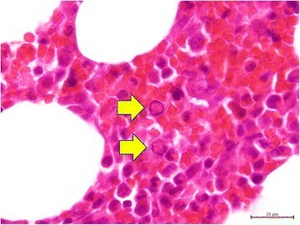Reticulocytopenia
(Redirected from Aplastic crisis)
| Reticulocytopenia | |
|---|---|
| Other names: Aplastic crisis, Marrow failure | |
Reticulocytopenia is the medical term for an abnormal decrease of reticulocytes in the body. Reticulocytes are new, immature red blood cells.
Reticulocytopenia is usually a result of viral parvovirus B19 infection, which invades and destroys red blood cell precursors and halts the red cell production.
If infection occurs in individuals with sickle cell anemia,[1] spherocytosis, or beta thalassemia, it will lead to incorporation of two anemia-induced mechanisms: decreased red cell production and hemolysis. The result is a rapid and severe anemia (aplastic crisis) which may require blood transfusion.[citation needed]

See also
- Erythropoiesis – process of creating red blood cells
- Hemolytic anemia – reduced number of red blood cells due to destruction of the cells after they were made
- Nutritional anemia – reduced number of red blood cells due to vitamin deficiency or other dietary factors
- Spherocytosis- the shape of red blood cell becomes spherical than bi-concave.
References
- ↑ "Sickle Cell Disease - Basic Principles and Clinical Practice" Edited by Stephen H. Embury, Robert P. Hebbel, Narla Mohandas and Martin Steinberg. Copyright 1996 by Lippincott-Raven. Section IV p352.
External links
| Classification |
|---|